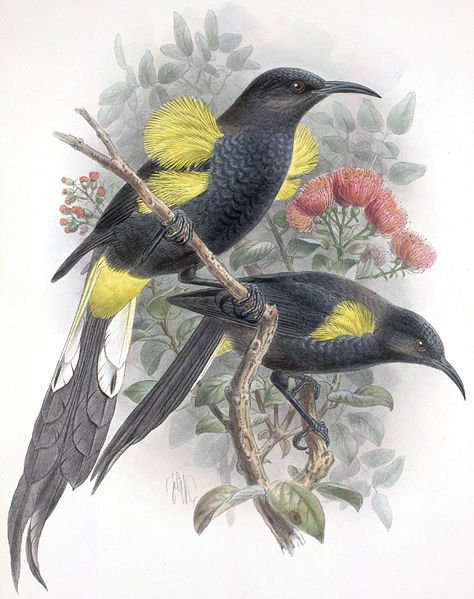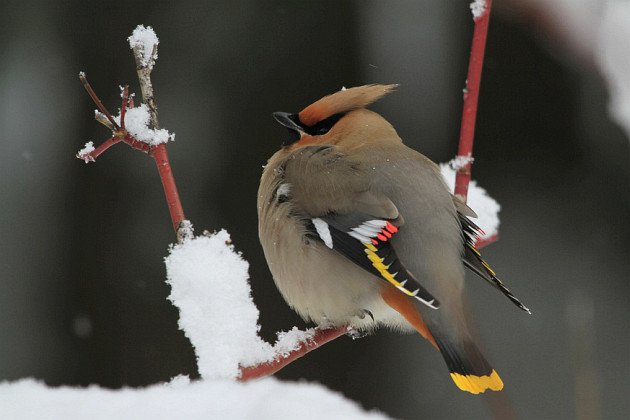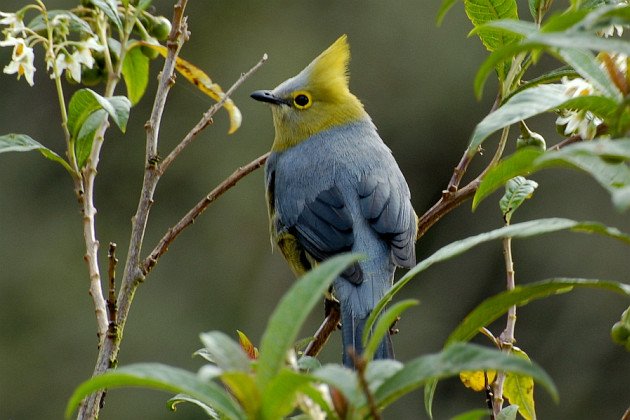
Waxwings and their relatives are a small, interesting group of songbirds that have seen some interesting taxonomic changes in the last few years. This group — dubbed the bombycillids, from the waxwing genus and family name — appears to fall near kinglets and a large group containing thrushes and muscicapids (Old World flycatchers and chats) in the passerine tree. We now have a much better idea of which birds belong in the bombycillid clade, thanks to a paper called Clarifying the systematics of an enigmatic avian lineage: What is a bombycillid? (Spellman et al. 2008), but how the bombycillid lineages are related to each other, and whether the various subgroups deserve family, subfamily, or tribe status, all still remains to be seen. (Cedar Waxwings are pictured above in a lovely image by Minette Layne.)
Meet the bombycillids:
Palmchat
First, we turn to the Caribbean island of Hispaniola, where dwells a dusky, streaky, sociable bird called the Palmchat (Dulus dominicus). The Palmchat has long been grouped with waxwings and silky-flycatchers based on morphological similarities, and genetic work has confirmed the relationship. The Society for the Conservation and Study of Caribbean Birds has more on the Palmchat.
Hypocolius
The Hypocolius (sometimes styled as Grey Hypocolius, Hypocolius ampelinus) is a fruit-eating, migratory bird of southwest Asia. Its genus name refers to supposed similarities between it and the African mousebirds, and its species name refers to waxwings. Spellman et al. placed the Hypocolius with “sufficient” confidence firmly within the bombycillid clade, noting in particular a certain genetic mutation shared with other members of the group.
This unique bombycillid is much-sought by birders visiting the region, and our own Redgannet encountered a flock in Saudi Arabia a couple of winters ago.
Olive-flanked Whistler
The Olive-flanked (or Yellow-flanked) Whistler (Hylocitrea bonensis) is endemic to to the island of Sulawesi in Indonesia, where it lives inconspicuously in montane forests. It is included in the Australasian whistler family (Pachycehpalidae) without comment in Birds of Wallacea (Coates and Bishop 1997), who note that it “feeds on small berries (mainly) and arthropods.”
Spellman et al. discovered, much to everyone’s surprise, that the Olive-flanked Whistler is a bombycillid, “a systematic relationship,” they wrote, “never previously hypothesized.” Don Roberson has a good page on the Olive-flanked Whistler.
Hawaiian Honeyeaters
Just months after Spellman et al. published their paper, Fleischer et al. made a big splash with the revelation that the Hawaiian honeyeaters (genera Chaetoptila and Moho) and were not honeyeaters at all, but bombycillids (Convergent Evolution of Hawaiian and Australo-Pacific Honeyeaters from Distant Songbird Ancestors, 2008). The excitement of this news, however, was tempered by the fact that all five species of this distinctive Hawaiian lineage are extinct, most having disappeared by the middle of the 20th century and the last, the Kauai Oo, flickering out forever in the mid-1980s. Here’s the only known video footage of that species: Kauai Oo.
Like the Australasian honeyeaters (family Meliphagidae), the Hawaiian honeyeaters had complex, tube-like, brush-tipped tongues and long, curved bills, enabling them to feed on nectar (illustrations included in the paper linked above). Christopher Taylor has more.

Hawaii Oo (Moho nobilis), depicted by John Gerrard Keulemans in 1893. This species’ brilliant yellow feathers were once incorporated into capes for Hawaiian kings.
Waxwings
Waxwings brighten winter days for many of us across the Northern Hemisphere, capturing the imagination with their flashes of color and their irruptive nature and highly gregarious behavior. The world has three waxwing species: the Cedar Waxwing (Bombycilla cedrorum), breeding in North America and wintering as far south as the Caribbean islands and northern Colombia; the Holarctic Bohemian Waxwing (Bombycilla garrulus); and the east Asian Japanese Waxwing (Bombycilla japonica).
In previous 10,000 Birds posts, Mike explained the structure and purpose of the “waxy” tips on waxwings’ wings (What Is a Waxwing?), and Corey explained how to tell the difference between Cedar and Bohemian waxwings.

Bohemian Waxwing (Bombycilla garrulus) by David Restivo, National Park Service
Silky-Flycatchers
Four species of silky-flycatchers (genera Phainoptila, Phainopepla, and Ptilogonys) occur in the Neotropics, and in the case of the Phainopepla (Phainopepla nitens), range as far north as northern California. They are attractive birds with, as their group name indicates, soft-looking plumage, and like many other bombycillids eat primarily fruit and arthropods.

Long-tailed Silky-flycatcher (Ptilogonys caudatus) cc-by Greg Gilbert










I so want to see a Long-tailed Silky-flycatcher now. Great post!
And that silky-flycatcher…
Have I mentioned how much I want to see that silky-flycatcher?
Yes, they are spectacular. I saw them in Costa Rica, distantly at the top of a tree.
This past week over 100 Cedar Waxwings have been hanging out in the trees on campus where I work (David, I hope you remember the place!). So I’ve counted them for the GBBC.
I see them quite often up on Poas volcano- a 40 minute drive from the house. Come on down and we will go see a bunch!!
I too suffer from Silky-Flycatcher envy. Dipped in Costa Rica last month on Long-taileds…LIFE IS PAIN.
Hawaiian bird news is such a bummer.